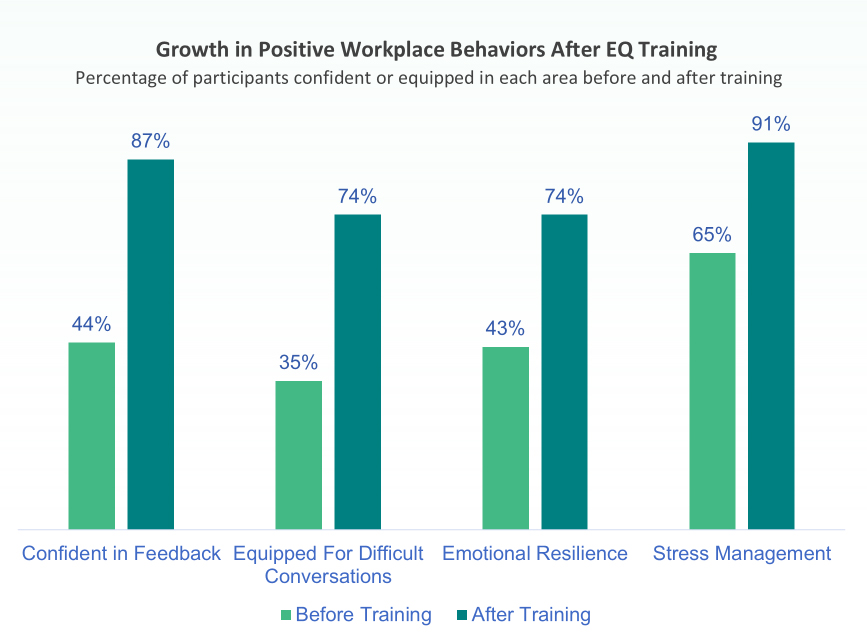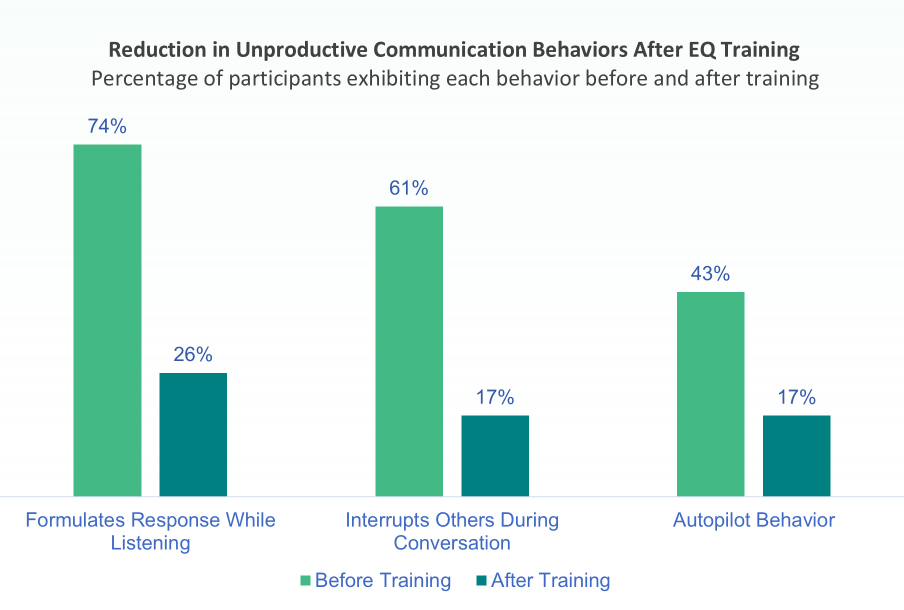Organizations are no longer satisfied with training that feels good in the moment but fades in the rearview mirror. In today’s pressure-filled workplace, HR and L&D leaders are being asked to connect learning programs to hard metrics: behavior change, emotional resilience, reduced burnout, better decision-making, and cultural transformation.
At TalentSmartEQ, we believe emotional intelligence (EQ) isn’t just a “nice-to-have” skillset—it’s the bridge between knowledge and action, between intention and impact. And, we have the data to prove it.
Two recent programs demonstrate what happens when organizations go beyond feel-good moments and invest in EQ training designed for real-world change. Below, we take a closer look at what the numbers say.
The Problem with Smile Sheets
For years, many organizations have measured training success by one simple metric: the post-session survey. Participants might rate the trainer a 10/10, say the content was “engaging,” and may even leave saying “that was the best training I have ever had!” But three months later? The question shouldn’t be “Did they like it?” It should be “Are they doing anything differently?”
While that kind of feedback (often called a “smile sheet”) can help you understand how a training felt, it doesn’t tell you what people are doing with the experience. Are they applying new skills under pressure? Are team dynamics shifting? Are leaders communicating more effectively?
It’s critical that learning professionals measure the real effects of their EQ initiatives, before, during, and long after the session ends. That’s where a strategic EQ approach, coupled with measurement and evaluation services, can make all the difference.
Case Study #1: Warren Police Department
In the high-stakes world of law enforcement, the stakes for emotional intelligence couldn’t be higher. For the Warren Police Department, located outside Detroit and serving a population of 140,000, the goal wasn’t just to check a training box, it was to reduce use-of-force incidents, support officer wellness, and improve decision-making in moments of extreme pressure.
Captain Brent Chisolm described the challenge clearly: Officers weren’t failing because of a lack of knowledge. “They knew what to do,” he said. “But something was happening in that moment—that critical second—where things go bad.” The department needed a way to close the gap between theory and action, especially under stress. That bridge was emotional intelligence.
Program Design
The department certified four internal trainers through TalentSmartEQ’s Mastering EQ Level 1 program and launched a department-wide rollout to over 200 sworn officers. Every officer:
- Took the Emotional Intelligence Appraisal® – Self Edition
- Participated in an 8-hour in-person training session
- Received follow-up nudges and reminders
- Is scheduled for annual retesting to track growth
The training received state approval through MCOLES (Michigan Commission on Law Enforcement Standards), and the department secured grants to cover the cost of the training.
Results That Matter
The data spoke volumes. Officers reported using EQ skills most frequently in high-stakes situations:
- 47% said the training helped them most with problem solving
- 34% cited EQ positively improved stress management
- 31% indicated an increase in adaptability and flexibility
And based on a Learner Impact survey measured 3-months post program, we saw a positive impact on a number of critical skills including:
| Skill | Before | After |
| Handling Difficult Conversations | 71% | 75% |
| Connecting on an Emotional Level | 63% | 74% |
| Coping with Stress at Work | 63% | 69% |
| Recovering from Emotionally Challenging Situations | 61% | 69% |
| Noticing How Mood Impacts Thinking & Behavior | 53% | 65% |
These improvements weren’t hypothetical. They were tied directly to moments that determine officer safety, career sustainability, and community trust. As Captain Chisolm said, “We’re not seeing the same problems and use-of-force issues that we had before.”
Case Study #2: University of Nebraska Extension
In a very different context, the University of Nebraska Extension also turned to EQ as a solution for challenges around communication, conflict, and stress management. As a statewide educational and outreach system for over 93 counties, the Extension system relies on its people to build deep relationships in the communities they serve.
According to Lisa Kaslon, PhD, Professional Development Coordinator, the missing piece wasn’t technical knowledge, it was people skills. “Everything we do is based on relationships,” she noted. “So much of it relies on their emotional intelligence.”
A Year-Long EQ Journey
The Nebraska Extension team opted for a 12-month EQ program, now in their 3rd cohort. The program includes:
- Self-assessment and individual development plans
- In-person Level 1 and Level 2 Mastering EQ training
- Monthly check-ins with facilitators or accountability partners
- Multi-rater (360) feedback at the halfway point
- A full post-program retest and impact study
Lisa, whose PhD research focused on the transfer of training, knew that training doesn’t stick if it is not reinforced and sustained over time. “Managing your own emotions and those of others is an ongoing process,” she explained. The year-long design encouraged practice, reflection, peer support, and targeted improvement over time.
Meaningful Behavior Change
Among those who completed the full retest:
- EQ scores increased from an average of 72 to 78
- Relationship Management improved by 7 points—the highest among the four core skills
As a result of these gains, participants reported meaningful improvements in workplace behaviors.
 |
|
 |
|
These are exactly the kinds of shifts that affect not only individual wellbeing but also organizational performance and culture. “Our employees are doing things differently,” Lisa said. “And they bring that to their work.”
Lessons for L&D and HR Leaders
These two organizations—one public safety, one educational—are very different. But their success with EQ training shares a few key takeaways for any leader designing learning programs:
-
Start with KPIs, not just content
Before launching any training, define what success looks like.
- Are you trying to reduce turnover? Look at what is happening in 1:1s. Are managers having real conversations or performance theater? Are you seeing improvement in performance metrics or the annual culture survey?
- Want to improve leader effectiveness? Look at language. Pull 100 random internal emails and look for “I feel” statements, acknowledgement of others’ perspectives, and boundary-setting language.
- Focused on accountability? Focus on project completion and speed to getting things done. The less time people are spending ignoring difficult conversations or not managing conflict, the more time they have to actually work together and get things done faster.
- Need to strengthen team collaboration? Look at how people are handling mistakes. Speed of ownership of mistakes is a direct measure of EQ culture.
Your evaluation approach should be built around those goals.
-
Go beyond one-and-done sessions
Learning isn’t an event, it’s a process. Both case studies featured multi-phase learning with assessments, reinforcement, and peer support. That’s what drives real behavior change.
-
Measure what matters
Don’t rely on post-session ratings alone. Pre/post assessments, multi-rater feedback, pulse surveys, impact studies, and follow-up interviews offer far richer insight into what’s working, and what’s not.
-
Build internal capability
Both organizations invested in internal facilitators trained and certified to deliver TalentSmartEQ content. This builds capacity and sustainability from within.
A Final Word
If you’re investing in EQ training, coaching, or assessments, ask yourself this: Will we be able to show what changed? At TalentSmartEQ, we partner with organizations not just to deliver content, but to help you move the needle on the metrics that matter to you.
We offer not only assessments and facilitation, but full evaluation services that help you define KPIs, measure outcomes, and prove return on experience (ROE) and return on investment (ROI). Whether you’re in healthcare, education, financial services, tech, or public safety, the principles are the same:
- People need to manage themselves under stress.
- Leaders need to listen better and communicate more clearly.
- Organizations need to see and sustain behavior change.
Let’s move beyond smile sheets. Let’s build cultures of emotional intelligence, measurably.